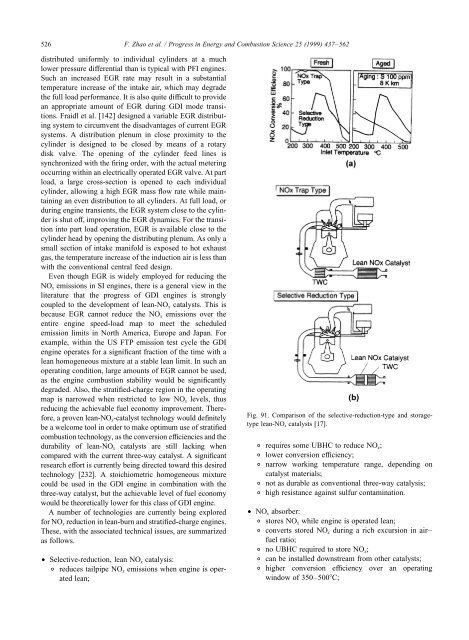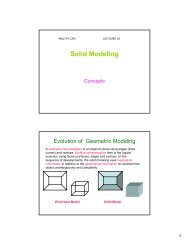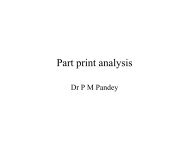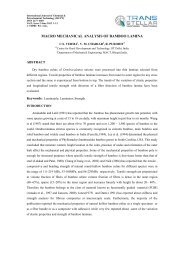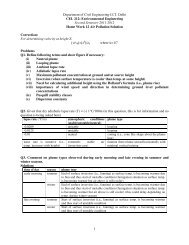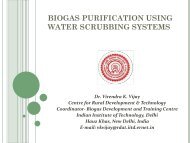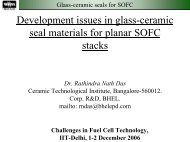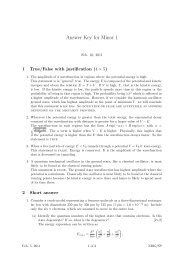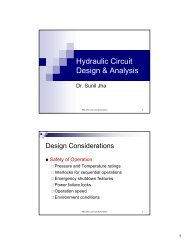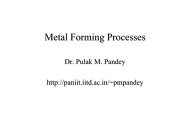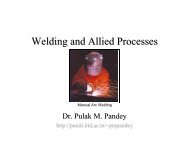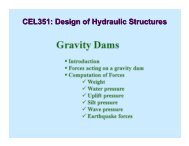Automotive spark-ignited direct-injection gasoline engines
Automotive spark-ignited direct-injection gasoline engines
Automotive spark-ignited direct-injection gasoline engines
Create successful ePaper yourself
Turn your PDF publications into a flip-book with our unique Google optimized e-Paper software.
526<br />
F. Zhao et al. / Progress in Energy and Combustion Science 25 (1999) 437–562<br />
distributed uniformly to individual cylinders at a much<br />
lower pressure differential than is typical with PFI <strong>engines</strong>.<br />
Such an increased EGR rate may result in a substantial<br />
temperature increase of the intake air, which may degrade<br />
the full load performance. It is also quite difficult to provide<br />
an appropriate amount of EGR during GDI mode transitions.<br />
Fraidl et al. [142] designed a variable EGR distributing<br />
system to circumvent the disadvantages of current EGR<br />
systems. A distribution plenum in close proximity to the<br />
cylinder is designed to be closed by means of a rotary<br />
disk valve. The opening of the cylinder feed lines is<br />
synchronized with the firing order, with the actual metering<br />
occurring within an electrically operated EGR valve. At part<br />
load, a large cross-section is opened to each individual<br />
cylinder, allowing a high EGR mass flow rate while maintaining<br />
an even distribution to all cylinders. At full load, or<br />
during engine transients, the EGR system close to the cylinder<br />
is shut off, improving the EGR dynamics. For the transition<br />
into part load operation, EGR is available close to the<br />
cylinder head by opening the distributing plenum. As only a<br />
small section of intake manifold is exposed to hot exhaust<br />
gas, the temperature increase of the induction air is less than<br />
with the conventional central feed design.<br />
Even though EGR is widely employed for reducing the<br />
NOx emissions in SI <strong>engines</strong>, there is a general view in the<br />
literature that the progress of GDI <strong>engines</strong> is strongly<br />
coupled to the development of lean-NO x catalysts. This is<br />
because EGR cannot reduce the NOx emissions over the<br />
entire engine speed-load map to meet the scheduled<br />
emission limits in North America, Europe and Japan. For<br />
example, within the US FTP emission test cycle the GDI<br />
engine operates for a significant fraction of the time with a<br />
lean homogeneous mixture at a stable lean limit. In such an<br />
operating condition, large amounts of EGR cannot be used,<br />
as the engine combustion stability would be significantly<br />
degraded. Also, the stratified-charge region in the operating<br />
map is narrowed when restricted to low NO x levels, thus<br />
reducing the achievable fuel economy improvement. Therefore,<br />
a proven lean-NOx-catalyst technology would definitely<br />
be a welcome tool in order to make optimum use of stratified<br />
combustion technology, as the conversion efficiencies and the<br />
durability of lean-NOx catalysts are still lacking when<br />
compared with the current three-way catalyst. A significant<br />
research effort is currently being <strong>direct</strong>ed toward this desired<br />
technology [232]. A stoichiometric homogeneous mixture<br />
could be used in the GDI engine in combination with the<br />
three-way catalyst, but the achievable level of fuel economy<br />
would be theoretically lower for this class of GDI engine.<br />
A number of technologies are currently being explored<br />
for NO x reduction in lean-burn and stratified-charge <strong>engines</strong>.<br />
These, with the associated technical issues, are summarized<br />
as follows.<br />
• Selective-reduction, lean NO x catalysis:<br />
◦ reduces tailpipe NOx emissions when engine is operated<br />
lean;<br />
Fig. 91. Comparison of the selective-reduction-type and storagetype<br />
lean-NOx catalysts [17].<br />
◦ requires some UBHC to reduce NO x;<br />
◦ lower conversion efficiency;<br />
◦ narrow working temperature range, depending on<br />
catalyst materials;<br />
◦ not as durable as conventional three-way catalysis;<br />
◦ high resistance against sulfur contamination.<br />
• NO x absorber:<br />
◦ stores NOx while engine is operated lean;<br />
◦ converts stored NOx during a rich excursion in air–<br />
fuel ratio;<br />
◦ no UBHC required to store NOx;<br />
◦ can be installed downstream from other catalysts;<br />
◦ higher conversion efficiency over an operating<br />
window of 350–500C;


